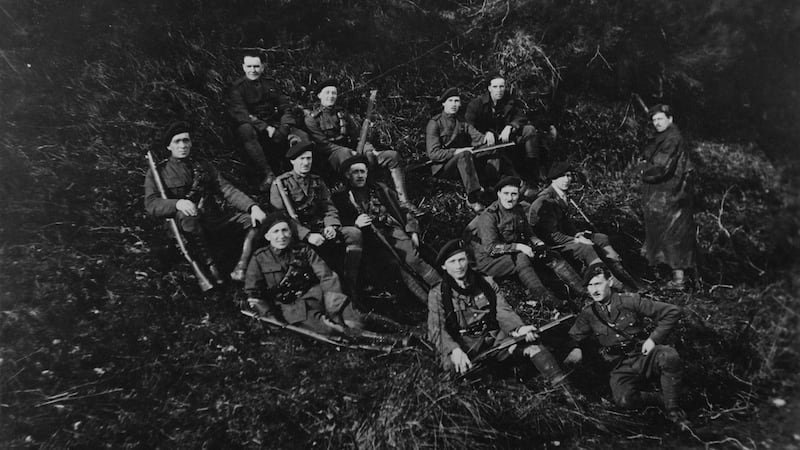There was more than one war of independence being fought in Ireland in 1920. Alongside an increasingly intense military conflict, there were political, psychological, intelligence and propaganda battles.
While assassination, reprisal and counter-reprisal generated the headlines, especially in the second half of 1920, there was also the ongoing attempt by Sinn Féin and the IRA to supplant the British administration in Ireland in the areas of local government and the administration of justice, and to internationalise the Irish question, with mixed results. Sinn Féin local election victories in 1920 were sweeping, but Sinn Féin president Éamon de Valera’s long tour of the US did not result in the declared Irish republic being endorsed at the most senior level of American politics.
The year was marked by violence, trauma and terror in Ireland; what Dr Daniel Cohalan, the Catholic archbishop of Cork, called "a devil's competition". Controversial events included the assassination of assistant commissioner of the Dublin Metropolitan Police, William Redmond, the murder of Sinn Féin lord mayor of Cork Tomás Mac Curtain, serious riots in Derry, and the Restoration of Order in Ireland Act.

September brought the Sack of Balbriggan and in October Mac Curtain's replacement as lord mayor of Cork, Terence MacSwiney, died after a 74-day hunger strike in Brixton prison ("If I die I know the fruit will exceed the cost a thousand fold" he had written the previous month), while the same month the Ulster Special Constabulary was formed.
November brought even worse violence, including the the execution of 18-year-old student Kevin Barry, and Bloody Sunday on November 21st when the assassination of suspected British intelligence agents, retaliation in Croke Park and the killing of key IRA figures amounted to the most lethal day of the War of Independence, with more than 30 killed and 60 seriously wounded, prompting the assertion that Dublin "has reached the nadir of moral and political degradation".
At the end of that month, during the Kilmichael ambush in Cork, 17 Auxiliaries were killed in vicious hand-to-hand combat: one Auxiliary victim had "a large compound fracture of the skull through which the brains protruded, this being inflicted after death by an axe or some similar heavy weapon". The Burning of Cork came the following month; a revenge attack that saw 40 business premises and 300 houses aflame and the loss of some 2,000 jobs.
The end of the year also delivered the enactment of the Government of Ireland Bill that partitioned Ireland and catered for Ulster unionist demands by creating a new state of Northern Ireland.
A revolution of the young and the inexperienced
A century later, how do we make sense of the enormity of what happened in Ireland in 1920? Partly by recognising that neither side in this conflict had a confident master plan. For the IRA, the war was not the vindication of astute centralised control but rather, in the words of historian Joost Augusteijn, "a mixture of coincidence, unintended outcomes and local initiatives."
It was a revolution of the young and the inexperienced; the average age of a rank-and-file Republican military volunteer in 1920 was 24 and for officers 26. Sources in the Irish Military Archives suggests the IRA from 1920-21 had a nominal national strength of 115,550, almost all part-time, which is just as well given that activists had access to perhaps only 3,000 rifles. Cumann na mBan, the female auxiliary of the IRA, had up to 20,000 nominal members by the height of the War of Independence, but it had an uneven national organisation, as did the IRA.
The relationship between the IRA and the underground Dáil government established in 1919 was never straightforward; not every IRA volunteer took an oath of loyalty to the Dáil, local leadership was highly variable and many lines were blurred. The IRA did succeed, however, in moving towards a more focused, coherent and effective military strategy as the year progressed.
Britain struggled in response and the rhetoric used by senior British politicians and supposed military masterminds in 1920 was highly disingenuous. The chief secretary for Ireland, Hamar Greenwood, insisted the Irish situation was under control while prime minister David Lloyd George at a speech in London in November announced "we have murder by the throat".
In truth, the maintenance of law and order had long crumbled and Dublin Castle struggled to put together an effective, unified security command. When long-sealed classified documents became available to historians, they revealed a vast accumulation of frustration, error and confusion within the Dublin Castle administration, the crown forces and the British cabinet. Ultimately, Winston Churchill, as secretary of state for war, was to acknowledge "the failure of force".

By the end of 1920, the 10,000 strong Royal Irish Constabulary was augmented by more than 10,000 Black and Tans and Auxiliaries alongside up to 40,000 regular British army troops and the war was costing the British government £20 million a year.
But who was in charge? Nevil Macready, the commander of the British forces in Ireland, did not want the job and admitted, “I loathe the country”; while he brought more efficiency and modernisation to the military effort, he had no inclination to take control of the police. As far as he was concerned, only a sweeping, draconian military response (“Cromwellian severity”) could crush the IRA and such an approach was not politically feasible.
Lust for revenge
The Auxiliaries, an elite, well-paid strike force, reported directly to Hugh Tudor, police adviser to Dublin Castle, who insisted they would make Ireland "an appropriate hell for those whose trade is agitation".
What compromised the Auxiliaries and Black and Tans aside from drunkenness and indiscipline was the lack of co-ordination between the RIC, army and Directorate of Intelligence in London. This gradually improved but efforts were undermined by the type of warfare being waged; crown forces were frustrated "if they could not identify a person as being a civilian or combatant" and the Auxiliaries' lust for revenge grew, as seen when Pat and Harry Loughnane in Galway had their hands tied and were tethered to the rear of a lorry, dragged for miles and then executed; of Harry, "nothing remained of his face except his chin and lips and the skull was entirely blown away".
Revenge attacks, authorised and unauthorised, damaged Britain's reputation; as the London Weekly New Statesman put it at the end of 1920, senior British politicians and military "know that murder, theft and arson are becoming commonplace in whatever part of Ireland the Black and Tans enter". Republicans fared better in the propaganda battle, Michael Collins concluding, "real progress is much more to be estimated by what is thought abroad than at home".
But there were tensions within the IRA also. Despite its often-effective use of guerrilla warfare tactics, and its ability to make more of an impact than its numbers and resources merited, historians in recent years have highlighted the dirty underbelly of the war, including the killing and intimidation of civilians.
There were chilling executions and anger about alleged spies and informers; it is estimated 196 civilians were killed by the IRA during the war of independence, 72 per cent of them Catholic. The violence took a considerable toll on innocent citizens, bystanders and onlookers who had to obey curfews, endure crossfire and, as the war intensified, continuous raiding and casual cruelty.
Michael Collins’ intelligence hierarchy was working ruthlessly, routinely and effectively a lot of the time but British forces had overwhelming superiority in conventional military force. What was recognised by the end of 1920 by both sides was that a reassessment of the nature and objectives of the war was necessary; that the status of Britain’s empire might be better served by getting out of southern Ireland through means of a political compromise, and that while the IRA could continue a guerrilla campaign, its possibilities were not inexhaustible, and civilian fatigue was growing. But the political climate was not yet conducive to a ceasefire.
Relive glory days
With the passage of time, the certainties and emphatic assertions in accounts of the War of Independence published in the 1940s and 1950s about “the unflinching support of a civilian population” and Republican Volunteers coming through the ordeal “with immaculate hands” appeared exaggerated and incapable of withstanding objective historical research.
Some wanted to romanticise and relive glory days but that was not always straightforward. As he faced death in the 1950s, IRA veteran and writer Ernie O’Malley recorded that the British were no longer his enemies: “each man finds his enemy within himself”.
Ideological climate, intergenerational shifts, the Troubles in Northern Ireland and an appetite for more complicated and inclusive narratives affected historical accounts of the period. In 1971, historian Leland Lyons warned that at that stage, the events of the early 1920s had "burned so deep into the heart and mind of Ireland that it is not yet possible for historians to approach it with the detailed knowledge or the objectivity which it deserves".
Forty years later, Charles Townshend observed, "Things have changed since them. The knowledge deficit has been substantially reduced. Objectivity may still be more difficult to achieve."
An avalanche of archival material in recent years has facilitated ever greater depth of research, but objectivity can still be a challenge, especially as current affairs and controversial commemorations can revive or facilitate fresh polarisations, distortions and simplicities.
As historian Roisín Higgins has suggested, commemorations of the War of Independence underline how historical memory is “deeply partial, personal and complex”. We have abundant archival sources for the Ireland of 1920, and considerable appreciation of the ironies and nuances of the war, but that does not mean we can easily achieve an untangling of its knotted legacy or rise above the emotion it still generates.
Diarmaid Ferriter is professor of Modern Irish History at UCD and an Irish Times columnist













